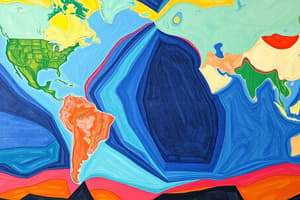Podcast
Questions and Answers
Which of the following sub-disciplines of Earth Science primarily focuses on the chemical composition and processes of the Earth?
Which of the following sub-disciplines of Earth Science primarily focuses on the chemical composition and processes of the Earth?
- Structural Geology
- Geochemistry (correct)
- Geomorphology
- Paleontology
At which type of plate boundary would you expect to find the formation of new oceanic crust?
At which type of plate boundary would you expect to find the formation of new oceanic crust?
- Transform boundary
- Divergent boundary (correct)
- Convergent boundary
- Subduction zone
The San Andreas Fault in California is an example of what type of plate boundary?
The San Andreas Fault in California is an example of what type of plate boundary?
- Convergent boundary
- Divergent boundary
- Transform boundary (correct)
- Subduction zone
What is the primary driving force behind plate tectonics that originates from the Earth's core?
What is the primary driving force behind plate tectonics that originates from the Earth's core?
What geological feature is commonly associated with oceanic-continental convergent boundaries?
What geological feature is commonly associated with oceanic-continental convergent boundaries?
Which of the following processes contributes to the 'ridge push' force in plate tectonics?
Which of the following processes contributes to the 'ridge push' force in plate tectonics?
What type of convergence is primarily responsible for the formation of the Himalayan mountain range?
What type of convergence is primarily responsible for the formation of the Himalayan mountain range?
Which of these areas of geology deals with the dating of rock layers and interpreting Earth's history?
Which of these areas of geology deals with the dating of rock layers and interpreting Earth's history?
What is the role of the asthenosphere in the theory of plate tectonics?
What is the role of the asthenosphere in the theory of plate tectonics?
Which force is primarily responsible for 'dragging' a subducting plate down into the mantle?
Which force is primarily responsible for 'dragging' a subducting plate down into the mantle?
Flashcards
Earth Science
Earth Science
Scientific fields related to the planet Earth, including its structure, composition, processes, and history.
Geology
Geology
Focuses on the Earth's physical structure, substance, history, and processes.
Plate Tectonics
Plate Tectonics
Theory explaining Earth's crust structure and phenomena via interacting lithospheric plates.
Divergent Boundaries
Divergent Boundaries
Signup and view all the flashcards
Convergent Boundaries
Convergent Boundaries
Signup and view all the flashcards
Oceanic-Continental Convergence
Oceanic-Continental Convergence
Signup and view all the flashcards
Oceanic-Oceanic Convergence
Oceanic-Oceanic Convergence
Signup and view all the flashcards
Continental-Continental Convergence
Continental-Continental Convergence
Signup and view all the flashcards
Transform Boundaries
Transform Boundaries
Signup and view all the flashcards
Mantle Convection
Mantle Convection
Signup and view all the flashcards
Study Notes
- Earth science is a broad term encompassing all scientific fields related to the planet Earth
- Includes the study of Earth's structure, composition, processes, and history
- Sub-disciplines of Earth science: geology, oceanography, atmospheric science, environmental science
Geology
- Focuses on the Earth's physical structure and substance, its history, and the processes that act upon it
- Includes the study of rocks, minerals, landforms, and the forces that shape them
- Key areas of geology: mineralogy, petrology, structural geology, geomorphology, paleontology, stratigraphy, economic geology, engineering geology, environmental geology, hydrogeology, geochemistry, geophysics
Plate Tectonics
- Theory explaining the structure of the Earth's crust and its associated phenomena as resulting from the interaction of rigid lithospheric plates that move slowly over the underlying mantle
- These plates float on the asthenosphere, a more ductile part of the upper mantle
Plate Boundaries
- Divergent boundaries: Plates move apart, resulting in upwelling of magma from the mantle to create new crust
- Mid-ocean ridges are a prime example of divergent boundaries, where new oceanic crust is formed
- Convergent boundaries: Plates collide, resulting in subduction (one plate slides beneath another) or collision (plates crumple and fold)
- Oceanic-continental convergence: The denser oceanic plate subducts beneath the continental plate, leading to the formation of volcanic arcs on the continental plate above
- Oceanic-oceanic convergence: One oceanic plate subducts beneath another oceanic plate, forming volcanic island arcs
- Continental-continental convergence: Both plates are buoyant, resulting in collision and mountain building (e.g., the Himalayas)
- Transform boundaries: Plates slide horizontally past each other, neither creating nor destroying lithosphere
- Earthquakes are common along transform boundaries (e.g., San Andreas Fault)
Driving Forces
- Mantle convection: Heat from the Earth's core drives convection currents in the mantle, which in turn exert forces on the lithospheric plates
- Ridge push: Newly formed crust at mid-ocean ridges is hot and elevated compared to the surrounding seafloor; as it cools and moves away from the ridge, it becomes denser and slides down the slope, pushing the plate ahead of it
- Slab pull: As an oceanic plate subducts into the mantle, it becomes denser than the surrounding mantle; this density contrast creates a force that pulls the plate downward, effectively dragging the rest of the plate along with it
Studying That Suits You
Use AI to generate personalized quizzes and flashcards to suit your learning preferences.




